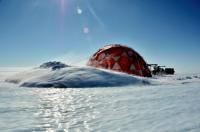


Gas bubbles trapped in the cores -- which are the oldest yet recovered -- contain pristine samples of carbon dioxide, methane and other gases that serve as "snapshots" of prehistoric atmospheric conditions and temperatures, the researchers recently reported in the journal Nature. The cores were collected in the remote Allan Hills of Antarctica.
First author Yuzhen Yan, who received his Ph.D. in geosciences from Princeton in 2019, explained that because ice flows and compresses over time, continual ice cores only extend back to 800,000 years ago. The cores he and his co-authors retrieved are like scenes collected from a very long movie that do not show the whole film, but convey the overall plot.
"You don't get a sense of how things changed continually, but you get an idea of big changes over time," said Yan, whose graduate research on ice cores supported by a 2016 Walbridge Fund Graduate Award for Environmental Research from the Princeton Environmental Institute (PEI) was a basis for the current work.
The ice cores reported in Nature are the latest to come out of the research group of senior author John Higgins, a Princeton associate professor of geosciences, PEI associated faculty and Yan's doctoral co-adviser. A previous team led by Higgins recovered a 1 million-year-old ice core from the Allan Hills, which was the oldest ice core ever recorded by scientists when it was reported in the journal Proceedings of the National Academy of Sciences in 2015. The cores were dated by measuring isotopes of the gas argon trapped in bubbles in the ice, a technique developed by co-author Michael Bender, Princeton professor of geosciences, emeritus, and PEI associated faculty.
"The ability to measure atmospheric composition directly is one of the biggest advantages of ice cores," Yan said. "That's why people spend years and years in the most isolated places getting them."
In the latest publication, the researchers use data from the ice cores to answer long-held questions about how our current glacial cycle emerged. Up until roughly 1.2 million years ago, Earth's ice ages consisted of thinner, smaller glaciers that came and went every 40,000 years on average.
Then, after what is known as the Mid-Pleistocene Transition, there emerged our current world characterized by colder and longer glacial cycles of 100,000 years. The two periods are known as the 40k and 100k world, respectively.
Some existing theories have stated that the 100k world -- which includes the last ice age that ended 11,700 years ago -- came about because of a long-term decline in atmospheric carbon dioxide, Yan said. But the researchers found that this was not the case -- average carbon dioxide was relatively steady through the 40k and 100k worlds. While the lowest temperatures and carbon dioxide levels of the 40k world were greater than the low points of the 100k world, the highest levels of both ages were similar.
"It could be the case that after the Mid-Pleistocene Transition, something occurred that lowered global glacial temperatures and atmospheric carbon dioxide values," Yan said. "This is the first time we have direct access to these greenhouse gas measurements. The ice core also opens up an array of new measurement possibilities that can give us insights into the 40k world when glacial cycles were very different from what we have today."
Although a long-term decline in average atmospheric carbon dioxide may not have directly led to the 100k world, the researchers nonetheless observed a correlation between carbon dioxide and global temperature, Bender said.
"To say that carbon dioxide is not a factor would be completely wrong," Bender said. "During the 40,000- and 100,0000-year glacial-interglacial cycles, temperature and global ice volume tracks carbon dioxide rather closely. Carbon dioxide changes are required to get from the cooler glacial temperatures to the warmer interglacial temperatures."
The amount of carbon dioxide now in the atmosphere tops 400 parts-per-million (ppm), which is nearly 100 ppm higher than the highest levels of the 40k world, Yan said.
"We're seeing carbon dioxide levels not seen in 2 million years," Yan said. "While our data suggest that long-term carbon dioxide decline was not the decisive factor in the Mid-Pleistocene Transition, it does not mean that carbon dioxide does not have the capability to bring about global-scale changes.
"We're in a different situation now -- carbon dioxide is the major player in our current world," he said. "If we want to look into the geologic past for an analogy of what's going on in our world today, we need to go beyond 2 million years to find it."
© 2025 NatureWorldNews.com All rights reserved. Do not reproduce without permission.





